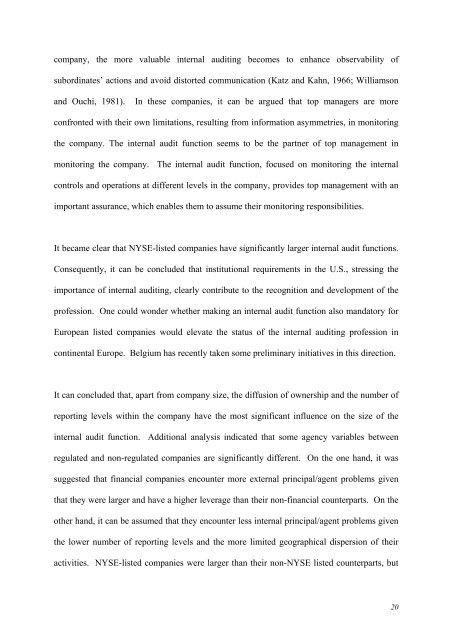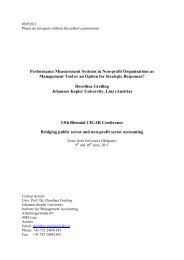WORKING PAPER - Faculteit Economie en Bedrijfskunde
WORKING PAPER - Faculteit Economie en Bedrijfskunde
WORKING PAPER - Faculteit Economie en Bedrijfskunde
You also want an ePaper? Increase the reach of your titles
YUMPU automatically turns print PDFs into web optimized ePapers that Google loves.
company, the more valuable internal auditing becomes to <strong>en</strong>hance observability of<br />
subordinates’ actions and avoid distorted communication (Katz and Kahn, 1966; Williamson<br />
and Ouchi, 1981). In these companies, it can be argued that top managers are more<br />
confronted with their own limitations, resulting from information asymmetries, in monitoring<br />
the company. The internal audit function seems to be the partner of top managem<strong>en</strong>t in<br />
monitoring the company. The internal audit function, focused on monitoring the internal<br />
controls and operations at differ<strong>en</strong>t levels in the company, provides top managem<strong>en</strong>t with an<br />
important assurance, which <strong>en</strong>ables them to assume their monitoring responsibilities.<br />
It became clear that NYSE-listed companies have significantly larger internal audit functions.<br />
Consequ<strong>en</strong>tly, it can be concluded that institutional requirem<strong>en</strong>ts in the U.S., stressing the<br />
importance of internal auditing, clearly contribute to the recognition and developm<strong>en</strong>t of the<br />
profession. One could wonder whether making an internal audit function also mandatory for<br />
European listed companies would elevate the status of the internal auditing profession in<br />
contin<strong>en</strong>tal Europe. Belgium has rec<strong>en</strong>tly tak<strong>en</strong> some preliminary initiatives in this direction.<br />
It can concluded that, apart from company size, the diffusion of ownership and the number of<br />
reporting levels within the company have the most significant influ<strong>en</strong>ce on the size of the<br />
internal audit function. Additional analysis indicated that some ag<strong>en</strong>cy variables betwe<strong>en</strong><br />
regulated and non-regulated companies are significantly differ<strong>en</strong>t. On the one hand, it was<br />
suggested that financial companies <strong>en</strong>counter more external principal/ag<strong>en</strong>t problems giv<strong>en</strong><br />
that they were larger and have a higher leverage than their non-financial counterparts. On the<br />
other hand, it can be assumed that they <strong>en</strong>counter less internal principal/ag<strong>en</strong>t problems giv<strong>en</strong><br />
the lower number of reporting levels and the more limited geographical dispersion of their<br />
activities. NYSE-listed companies were larger than their non-NYSE listed counterparts, but<br />
20
















